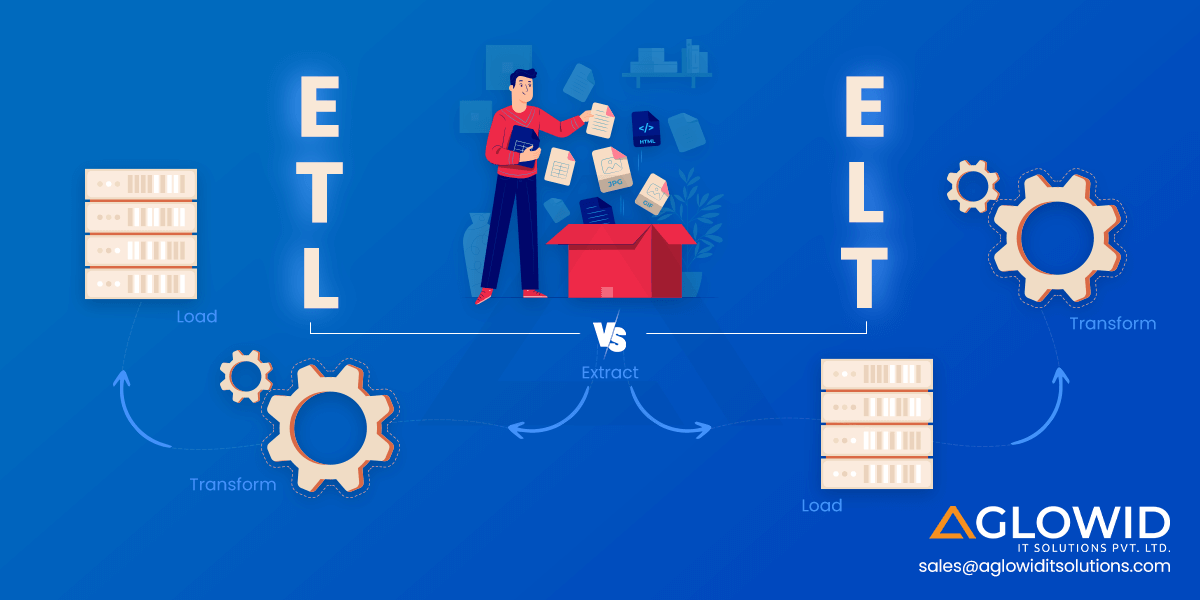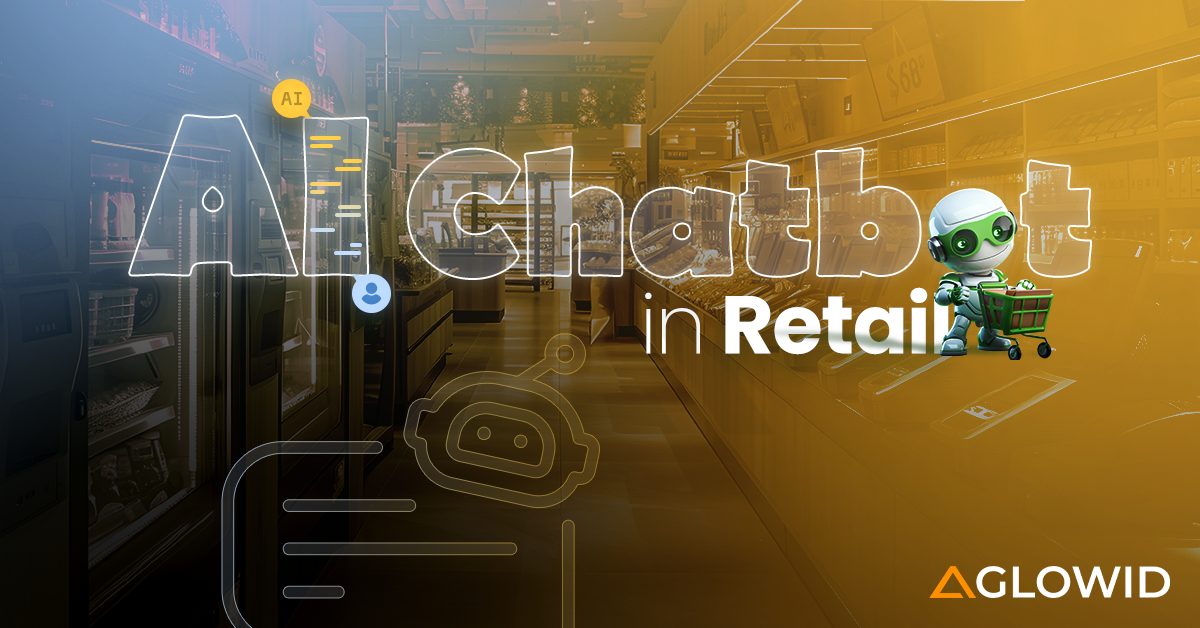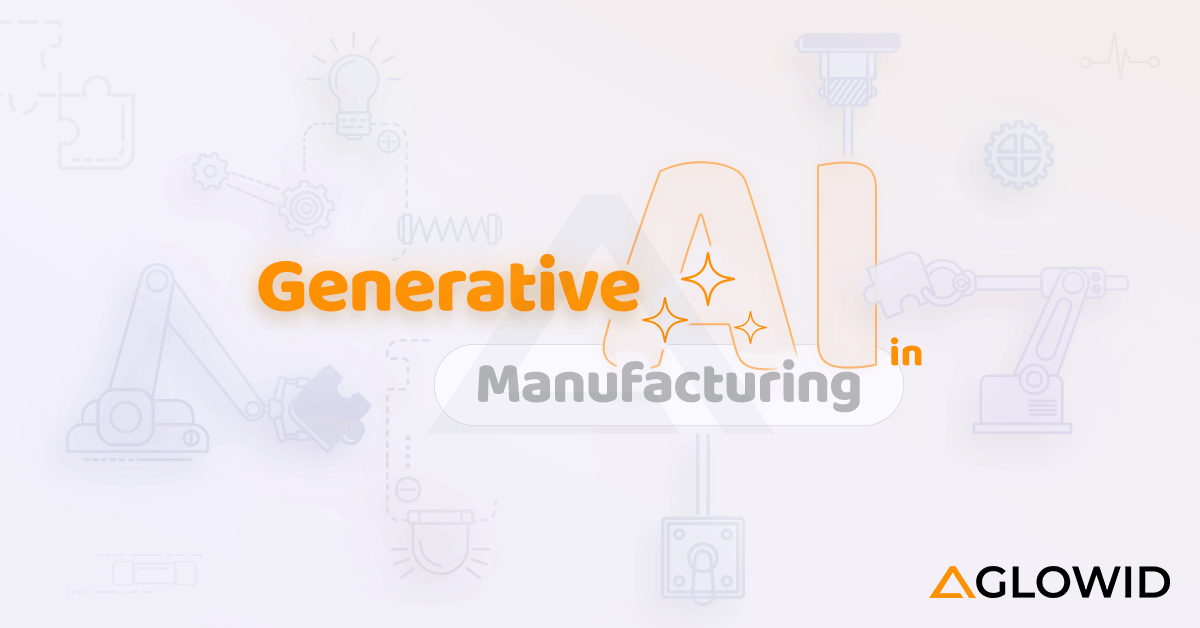Quick Summary:
Have you ever wondered how data seamlessly moves from source to destination? Enter ETL (Extract, Transform, Load) and ELT (Extract, Load, Transform). ETL transforms data before loading, suitable for structural data, while ELT loads first and transform within the destination, ideal for big data. Which method suits your data integration needs? The choice between ETL vs ELT depends on various factors and specific use cases requirements.
In this blog, we’re going to discuss📝
Data Integration is a crucial process for organizations that need to combine data from multiple sources into a unified view. According to the report by MarketsandMarkets, the data integration market size is projected to reach USD 19.6 billion by 2026, growing at the CGAR of 11.0%. As there is increasing data in the world, it comes with challenges. Here the question arises is how to accurately capture the data, structure it and analyze it for making important decision? Enter here – ETL & ELT.
These letters stand for Extract, Transform, Load
- Extract – It is the process of pulling the data from a source; it can be anything such as Relational or Non-relational databases, an XML file, or any cloud platform.
- Transform – It is the process of converting the structure or format of dataset to the target system.
- Load – It is a process of placing the data set into the targeted system.
The main difference between ELT vs ETL is when the data transformation happens. Let’s have an overview of them, and later in this blog, we will understand them in detail.
ETL stands for Extract – Transform – Load
In the ETL process, the data is first extracted from the source, it can be anything from database to XML file, and then the data is transformed before loading. As a result, transforming the data set can take a long time. Analysis can be done immediately once the ETL process is completed.

ELT stands for Extract – Load – Transform
On the other hand, in ELT process the data transformation is on as required basis in the target system itself. As a result, the transformation process may take a little time but it is important to keep in mind that analysis and query process will slow down.

Let’s take a deep dive into the world of ETL and ELT.
ETL vs ELT: What is ETL?
This section of the blog will give you an overview of ETL along with its benefits and challenges. Let’s begin!

ETL Process
With ETL, unstructured data gets extracted from a source system and directly loaded onto a target system for future transformation as required. This extracted data is accessible to business intelligence systems, eliminating the need for data staging. ELT employs data warehousing for fundamental transformations and real-time updates, particularly handling large volumes of raw data. Despite being newer than ETL, ELT has yet to fully realize its potential. Initially relying on hard-coded SQL scripts, it carries a higher risk of coding errors than the advanced ETL methods.
How ETL Process Works?
Understand how whole ETL process works with below pointers:

- Data is extracted from the source
- Data is then sent to the staging area with various ways. It is important to transform the data before it is loaded due to the constraints in the traditional data warehouses
- The data is then loaded into the target Data Lake /Mart / Lakehouse & is ready to be analyzed using Business Intelligence tools or Data Analytics Tools
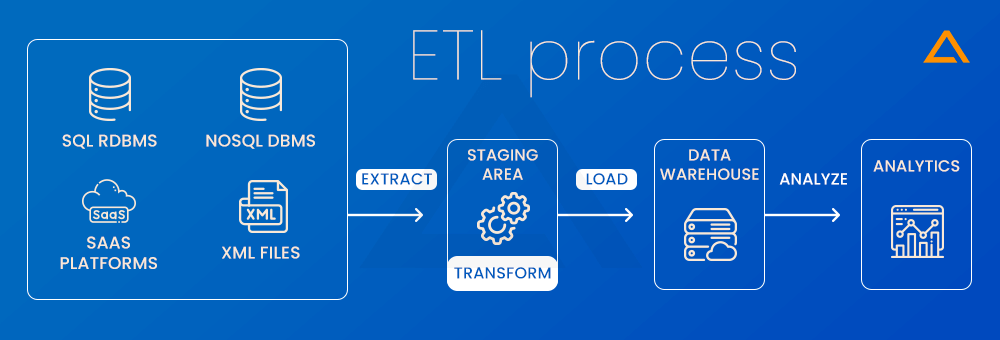
ETL vs ELT: Pros and Cons
There is no way to say the clear winner between ETL vs ELT. Both data integration techniques have their own benefits and limitations. Let’s take a look at advantages of ELT vs ETL one by one, starting with ETL.
ETL Pros
Maturity
As ETL was designed first then ELT in 1970s, and is in practice for more than two decades. This lead to have more experienced developers or engineers for the ETL implementations. It also means that comparatively there are more ETL tools than ELT tools to develop the data pipelines, with in the organizations.
Environment Flexibility
ETL process plays an important role in managing and optimizing the workflows. They are also versatile enough to be implemented in both on-premises and cloud environments. Organizations frequently use the ETL method to transfer their on-premises data to cloud based datastore.
Compliance
ETL transforms the data before it reaches to the designated destination. When companies are subject to the data privacy regulations such as GDPR. These compliances allow them to remove, mask or encrypt the sensitive information before its loaded in the designated datastore.
Fast analysis
Once of the key benefits of ETL is the data is structured and the queries are much more efficient and fast compared to the untransformed data.

ETL Cons
Workflow Rigidity
In cases where the existing data warehouse structure doesn’t align with the requirements for conducting new, identified valuable queries or analyses, adjustments might be necessary in both the transformation process and the data warehouse schema.
Data Volume
When it comes to dealing with large data volumes, there may be better choices than ETL due to the considerable time required for transformation. Its effectiveness shines in scenarios involving smaller datasets that demand complex manipulation and contain relevant information for analysis.
Loading Speed
As data is needed to be transformed in a staging area before its loaded, it is not loaded in the desired destination as quickly as ELT.
ETL vs ELT: What is ELT?
ELT differs from the traditional the ETL by loading raw data into destination before transformation process. Learn more about ELT below.

ELT Process
In ELT, raw data is extracted from the source system before it is loaded into the target system for subsequent manipulation as required. Once extracted, this unstructured data can be accessed by performance reporting systems without the need for a data staging step. ELT relies on the data warehouse for basic data transformations such as the acceptance or removal of data duplicates, where these processes are updated in real time to handle significant amounts of unstructured data Not withstanding being a relatively recent approach compared to previous ETL, ELT has yet to fully realize its potential. ELT systems that initially rely on hard-coded SQL scripts are more vulnerable to the possibility of coding errors as opposed to more advanced methods used in ETL.
How ELT Process Works?
Explore the complexities of the entire ETL process through the following pointers.

The process of ELT is similar to the process of ETL, the only difference relays in the data load sequence. In ELT, the data is first loaded in the destined designation and then transformed as needed.
The first step in the ELT process, is to extract the data from the source.
After the data is been extracted, it needs to be loaded. The loading process involves moving the data from the source to the data warehouse.
The third-step in the ELT process is the data transformation. Once the data is loaded it requires formatting, data structure, or performing calculating.
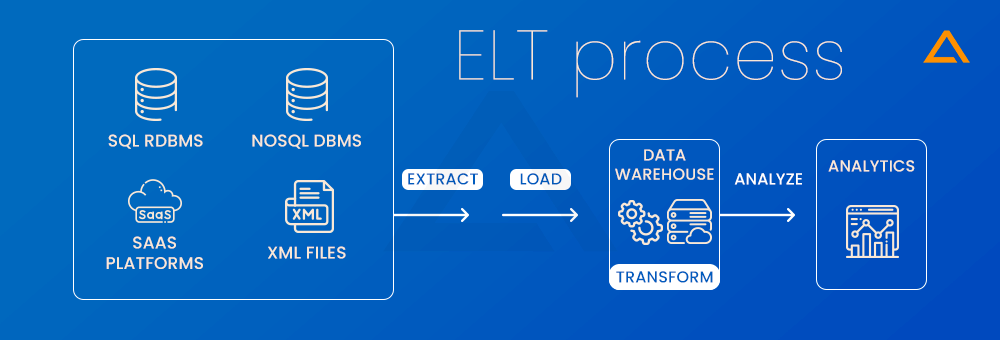
ETL vs ELT: Pros and Cons
By managing messy data after relocation, ELT enables faster implementation than ETL. It avoids migration delays due to coding errors by separating transformation from loading. Cloud solutions with ELT support a variety of data types and address server scalability issues by leveraging the processing capacity of data warehouses.
ELT Pros
Data Format Flexibility
ELT can take any data in any format when it is paired with a data lake. As the data leak accepts unstructured data, there is no need to account for schema.
Data Availability
ELT ensures that all data is constantly accessible by loading it into the data lake. Instead of waiting for the data to be modified, this enables technologies that don’t need structured data to engage with the supplied data right away.
Loading Speed
In ELT, the data is loaded on the destined designation, therefore there is no need for tools to wait for the structured data to interact with the loaded data and wait until it is transformed.
As needed Transformation
In ELT, transformation happens on as needed basis. That means that the transformation only happens when analysis is needed unlike ETL where the data is transformed before loading. This provides greater efficiency and resources.
Implementation Speed
The ELT model works like a versatile tool. It jumps into action when we need to transform data and easily handles new data sources, swiftly collecting information for the data lake. Meanwhile, engineers get the time to figure out the most effective ways to ask questions and make sense of the data.

ELT Cons
Compliance
Companies could face regulatory limitations on storing sensitive data, even if it’s eliminated during subsequent transformations. Additionally, the integration of ELT with the cloud poses a secondary challenge, as some regulations restrict the storage of information on servers situated beyond specific borders.
Analysis Speed
The delayed transformation occurring post-data loading, especially when dealing with substantial amounts of unstructured data, might delay the prompt generation of insights. Nevertheless, leveraging the robust computing power in the cloud can serve as an effective countermeasure to this potential slowdown in the analysis of large datasets.
Environment Flexibility
While theoretically feasible within an on-premise setting, the full benefits of ELT truly manifest when it is mutually coupled with the robust storage and processing capabilities inherent in cloud environments.
Modern Method
As cloud computing has evolved, ELT has also reached a level of maturity. Despite not having an extensive community backing, there’s a noticeable boost in both the tools available and the professionals supporting ELT.
Now that you have an overview of both ETL vs ELT, let’ s take a look at the ELT vs ETL difference.
A Quick Comparison: ETL vs ELT Difference
Several organizations use the ETL that ELT to cover the range of their data pipelines needs. pipeline is the side-by-side comparison of ELT vs ETL.
| Factors | ETL | ELT |
| Data Warehouse Support | Yes | Yes |
| Support for Data Lake / Mart / Lakehouse | Yes | Yes |
| Dataset Size | For small size of data | For any type or size of data |
| Ease of Use | User-Friendly | May require advance skill |
| Cost | Usually Costly | Cost-Effective |
| Hardware | Traditional ETL requires costly hardware | ELT is cloud-based no extra hardware is required |
| Compliance | ETL is better suited for compliance | ELT is not suited with compliance |
| Maturity | Is mature has existed for more than 2 decades | ELT is newer form of data integration |
| Privacy | Pre-load transformation can eliminate PII | Direct loading needs security layer |
| Maintenance | More Maintenance burden | Less Maintenance burden |
| Requeries | Cannot be requeried | Can be requeried |
| Data Output | Structured | Structured, Semi-structured, unstructured |
| Data Latency | Higher Data Latency | Lower data latency |

Searching for IT Superstars?
We’re the AugMENTIONED Ones! 👀🌟”
Aglowid provides the best IT Staff Augmentation Solutions
Now Let’s see the detailed in-depth comparison between ETL vs ELT.
ETL vs ELT Which Is Better: A Detailed Comparison
ELT and ETL are two different ways to handle data. ETL transforms data before putting it into a system, good for structured analytics. ELT loads raw data first, allowing flexibility for real-time analytics, data lakes, and using cloud resources. The choice depends on the specific needs of a project. Let’s take a look at the major differences between ELT vs ETL in detail.
ETL vs ELT: Maintenance
For both ELT vs ETL maintenance is the crucial prospect for robust performance. For ETL process key steps to include monitoring for expected operations, scheduled checks for errors & updates, taking backups to avoid data loss and lastly ensuring that the data quality throughout the consistent checks. Where on the other hand, in ELT process the emphasis is on the correct data transformation, verifying targets capacity, system monitoring, data loading and transformation are key parts of both ELT and ETL.
ETL vs ELT: Cost
ETL processes typically have higher costs than ELT processes due to the need for powerful servers and multiple databases for data transformation. In the ELT process, the cost saving arises from the reduced usage of processing power & database requirements. Additionally, ELT can result in lower data output costs, as data transformation occurs within the target warehouse or data lake, minimizing transfers and maximizing the speed.
ELT vs ETL: Process
ETL Process
In ETL, data is extracted from the source system, transformed in a format compatible with the target system. This sequential process, involving a dedicated transformation server, ensures data quality and consistency before reaching the target.
ELT Process
ELT initiates with Extracting raw data, loading it directly into the target system, and then Transforming it within the target environment. This approach, leveraging the power of the target system, prioritizes flexibility and scalability, allowing transformations to occur on-demand within the destination system.
ETL vs ELT: Security
ETL emphasizes pre-loading security with data transformations, heightening integrity, but security may be inversely proportional to performance. In contrast, ELT prioritizes security post-loading, minimizing risks during extraction, underscore ELT’s adaptability to dynamic security needs in evolving data environments.
ELT vs ETL: Performance
Performance is an important criterion to ensure that the ELT/ETL processes promptly process large data volumes. Poor performance can lead to the data warehouses and applications being unable to produce the information, or inconsistent data which can directly impact business operations. Performance is inversely propositional to the security. It is said that when you are focused on the security, you need to the sacrifice the performance. But do you? – Enter EtLT.
Although still very new, many consider ETLT be best of both the worlds. ETLT stands for Extract, Tweak, Load, Transform. It is a hybrid or best of both the fast and ensure the data quality when it comes to the sensitive information for compliance and regulations.
ETL vs ELT: Data Movement
In ETL, data goes through extraction, transformation, and loading, involving moving a lot of data. On the flip side, ELT could be more data-heavy. It extracts, loads, and then transforms data in the target system, reducing data transfer and minimizing the risk of issues. However, ELT needs a powerful target system for heavier processing.
ELT vs ETL: Flexibility & Scalability
Scalability is crucial when selecting the data integration process between ETL and ELT. ETL is a traditional method, which is efficient but flexible due to manual coding and slow transformations. Although a newer approach, ELT excels in flexibility and scalability, enabling easy changes and faster data transformations. Ultimately, the choice depends on the unique organizational needs.
ETL vs ELT: Data Loss
Data loss consideration is vital in choosing ETL or ELT for data transformation. Data extraction, transformation, and loading in ETL may result in loss due to discarded information. ELT, in contrast, moves all data before transforming, offering flexibility but with potential storage and performance challenges. The choice depends on trade-offs between flexibility and resource management.
ETL VS ELT: When to Use
The choice between ETL and ELT rest on the various factors. Here are some considerations for when to use ETL vs ELT.
Use ETL when you have:
- Data Transformation Complexity
- Data Warehouse-centric approach
- Resource constraints
- Security & Privacy concerns

Use ELT when you have:
- Raw data storage
- Cloud Scalability
- Data Lake / Mart / Lakehouse Integration
- Real-Time Processing
- Cost Considerations

ETL vs ELT: Use Cases
The choice between ETL (Extract, Transform, Load) and ELT (Extract, Load, Transform) depends on a data integration service project’s specific requirements and objectives. Here are common use cases for both ETL and ELT:
ETL Use Cases
Following are the use cases of ETL:

Structured Data Warehousing
ETL shines in scenarios where the primary aim is loading meticulously transformed and structured data into a centralized data warehouse, catering to traditional business intelligence and reporting needs.
Analytics Precision
When precision in analytics is paramount, and data demands meticulous transformation into a predefined schema before analysis, ETL emerges as the tool of choice.
Harmonizing Data Sources
ETL excels in the task of ensuring consistent data from diverse source systems and a cohesive and uniform perspective by consolidating information into a central data warehouse.
Thoughtful Batch Processing
In environments where thoughtful, batch-oriented data processing is the norm, ETL proves its mettle, seamlessly handling transformations in batches.
Finding Past Insights
ETL is the go-to solution for detecting past insights when historical data requires integration, transformation, and loading into a data warehouse for comprehensive historical analysis.
ELT Use Cases
The following are the use cases of ELT:

Navigating Data Lakes and Lakehouse
ELT navigates the realm of data lakes and lake houses with finesse, particularly suited for scenarios where raw or semi-structured data is loaded, offering flexibility for subsequent transformations.
Real-Time Analytical Prowess
ELT takes the lead for analytical tasks demanding real-time or near-real-time insights, enabling immediate data processing without the customary delay associated with upfront transformations.
Cloud-Powered Agility
Tailored for cloud-based architectures, ELT harnesses the agility and processing muscle of cloud platforms, making it the preferred choice for efficiently cost-effectively managing large volumes of data.
Schema-On-Read Versatility
ELT stands out in scenarios where a “schema-on-read” approach is favored, allowing users to define the schema dynamically during analysis rather than imposing a fixed structure during data loading.
Data Exploration Unleashed
In environments demanding free exploration and data discovery, ELT empowers analysts to dive into raw data in its native format, postponing transformations until insights beckon.
Embracing Data Diversity
ELT finds its strength in environments boasting diverse data sources and formats, effortlessly ingesting raw data without the need for extensive upfront transformations.
Bonus Tip: Shift from ETL to ELT
The transition from ETL to ELT has been gaining recognition as the standard for data integration. ETL was widely used in the past, especially when the target repository was a data warehouse. However, it is important to keep in mind that ETL comes in certain challenges. These challenges include expensive hardware requirement, Slower processing speed for ad-hoc analysis as the process needs to be repeated.
Apart from that, ETL also doesn’t support real-time analysis or machine learning projects, an essential requirement for a dynamic business environment. With the rise of cloud and agile development approach the shift from ETL to ELT has been accelerated. The Latest trend in the industry is decoupling the “T” from the monolithic structure of ETL, which gives flexible and effective data integration approach.
Take a look at the brief video below to know more about this.
ETL vs ELT: Which one to go for?
The choice in the ETL vs ELT debate depends on specific organizational needs and priorities. With its structured approach, ETL is efficient but needs to be more flexible. On the other hand, ELT offers greater flexibility and scalability, making it suitable for dynamic data environments. The decision is based on balancing efficiency, flexibility, and resource considerations to meet the unique requirements of the data integration process.
